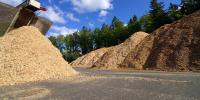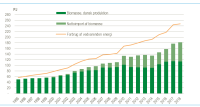
Biomass is the ‘elephant in the room’ that must be handled urgently
Negotiations for implementation of the Danish 70% reduction target by 2030 is under way, and the first sector agreement on energy and industry emissions was struck late June with a focus on renewable energy, energy savings, heavy industry, etc. The agreement includes needed mitigation measures and many good initiatives and elements that will contribute significantly to reaching our target. But the agreement does not address the "elephant in the room" - the massive biomass use in the energy sector. The handling of this specific question has been postponed to negotiations this fall, when new sustainability criteria for biomass are to be negotiated. But of course developing such criteria will not at all address how Denmark should move towards a sustainable use of biomass in the energy sector going forward, simply because it – so far – does not address the “elephant in the room” – the unsustainable amount of biomass used.
Below, the main challenges related to the extensive use of biomass are outlined, and specific recommendations to how biomass should be addressed are given.
Biomass accounts for two-thirds of Denmark's renewable energy total
A main driver for Denmark's reduction of greenhouse gases over the past decade is the transition in producing electricity from especially coal to wind and, partly as a result, the massive consumption of biomass in the heating sector. So yes, Denmark has invested heavily in wind energy, energy efficiency etc., but biomass accounts today for approx. 2/3 of renewable energy in the Danish energy mix (see figure 1 below). And yes, the burning of biomass surely counts as zero in the Danish carbon accounting, in accordance with the current UN accounting rules under the UNFCCC. But in reality, Denmark emits 14 million tons of CO2 a year via direct burning of biomass for heat and power, which is quite a substantial part of Denmark’s overall emissions (51 million tons of CO2 in 2018).

The rationale for the current UN rules is that these emissions are expected to be "neutralized" in the LULUCF inventory (stock in forest, etc.), either in Denmark or in the countries from which the biomass originate. However, burning of biomass result in significant net-emissions in the short and medium term, e.g. because of the "carbon debt" to the atmosphere until emissions are offset by the increase in forest stocks. In short, forests and other types of biomass will in the future need to be prioritized for uptake and storage of CO2 and for biodiversity purposes, and harvested products should primarily be used in the bio economy, and only to a limited extent for energy purposes, e.g. in developing and decarbonizing fuels for planes and ships.
Sustainable use of biomass is all about the amount used
Now, let us return to the question of how biomass should be included in an agreement this fall. As mentioned, the only formal negotiation theme on biomass, relates to the need for establishing sustainability criteria for the future use of biomass in the Danish energy system. Even though it is always positive to focus on ensuring the most sustainable use of any resource, the current or any future sustainability criteria do not ensure that the biomass use is carbon neutral or that the aggregated amount of biomass use is sustainable. In short, sustainable use of biomass requires limiting the total amount used.
In a recently published CONCITO note on the Danish consumption and prioritization of biomass for energy purposes, it is explained how the future sustainable use of biomass globally is closely related to assumptions on population growth, diet changes etc. The note summarizes findings from international studies underscoring the future very limited biomass availability if we are not able to significantly change food consumption globally, intensify food production, change population growth, etc. Indeed, these findings show that sustainable global biomass use per capita is approx. 1/3 of the 33 GJ that Danes consume annually.
Positively, there seems to be a growing political understanding across the political spectrum in Denmark, that the use of biomass is primarily a transition technology as we move from fossil fuels to the needed climate friendly energy sources: heat pumps, geothermal, surplus heat, etc. But, in light of the above, it is absolutely critical that the upcoming national climate agreement takes serious steps towards phasing out biomass as the most important energy source in the Danish energy system as soon as possible.
We know that the upcoming climate agreement and the overall climate plan to be negotiated in early fall, will include a suite of concrete targets, policies and measures, but it will also set a direction and send clear signals to investors, companies and citizens on how the Danish energy system will develop moving towards 2030.
And we know that there are important political decisions and investment decisions to be taken in the energy sector over the next few years, both in term of new and existing installations. In order of urgently addressing the overall amount used, while also respecting investments already made, the following elements on biomass should be included in an upcoming overall climate agreement:
1. The total amount of biomass for energy purposes must decreased significantly by 2030.
- Similar to the greenhouse gas inventory, an annual accounting of the total amount of biomass consumed in the Danish energy sector must be recorded and published.
- Considerations and possible political actions to enable a more sustainable biomass use, should be included as part of the already agreed annual policy cycle on climate action agreed in the new (draft) Danish Climate Law, in which both the Danish Climate Council, the Government and the Parliament play an active role.
- If the total amount of biomass used is not declining, and/or is not expected to decline significantly towards 2030 in existing investment scenarios, a biomass tax should be introduced no later than January 1st 2023 reflecting its net-climate impact.
2. No new baseload biomass plants are to be established, at neither decentral or central plants.
- Medium or peak load installations that can be depreciated before 2030 can be considered if there are no real green alternatives.
3. Already established biomass plants must move from baseload to peak load, or to completely different energy sources, before 2030.
- If carbon capture plants (CCUS) are established, it may be considered whether it is climate-relevant to maintain a limited biomass capacity, but CCUS should not in itself lock in a significant biomass consumption in Denmark in general. Capturing CO2 for storage or for use in industrial/fuel production (e.g. Power to X) in Denmark should also come from other relevant plants, e.g. production of concrete and central waste facilities.
The three elements listed above need to be a central part of upcoming climate and energy agreement. If, again, the substantial use of biomass is not adequately addressed, future Danish mitigation efforts risk becoming inadequate and will not address and reflect Denmark’s total emissions and aggregated climate impact. In other words, delivering on the Danish 70% reduction target should not be at the expense of delivering real mitigation and real climate effect.
In closing, we recommend that the Danish Parliament include the above elements as part of an agreement to transition to the green energy technologies of the future.
